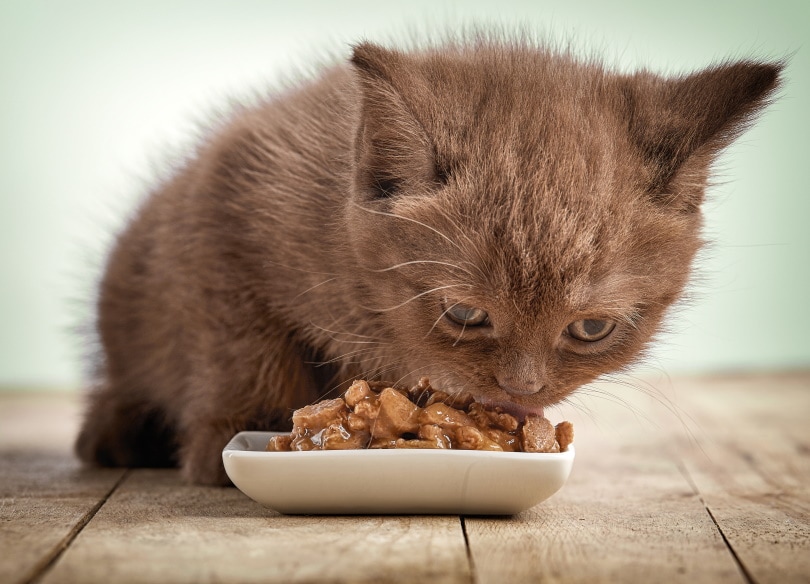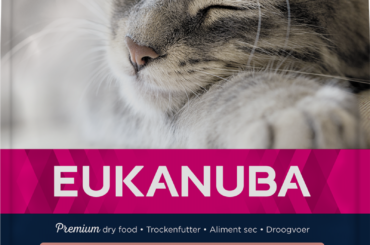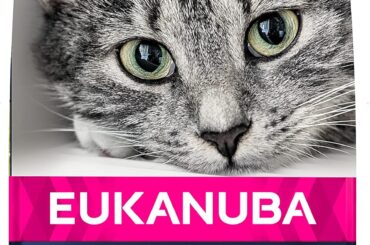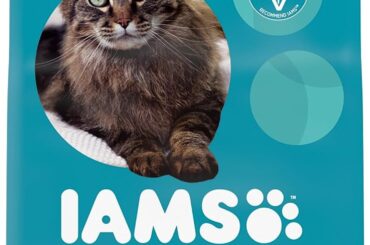These premium products will keep your pet happy and healthy.
More information regarding our evaluation process is available here. Independently researching, assessing, and recommending the top options are our editors. We may receive commissions on purchases made after clicking on one of our chosen links.
In contrast to adult cats, kittens need a distinct diet because they are still developing. Wet foods made specifically for kittens are a great way to wean them off of breastfeeding while also fostering their healthy and robust growth. Even though they do not yet have all of their teeth, they are nonetheless capable of eating and swallowing.
Overall, wet foods are great for kittens. Cats should be introduced to wet food at a young age, suggests Dr. Kerri Blackburn of the River’s Edge Animal Hospital in Rock Hill, South Carolina. More moisture in canned food can aid in the prevention of several common diseases and ailments that older cats are more likely to contract. She further asserts that giving cats canned food will increase their water intake because cats are not bred to consume a lot of water because of their desert origin.
Although wet food is recommended for all kittens, not all wet foods are the same. Dr. Blackburn asserts that canned foods with gravy, such as chunks, shreds, and so on, are actually quite rich in carbohydrates, particularly those that come in gravy. The traditional paté is the best kind of canned food. It can be challenging for a kitten owner to select the best wet food for his or her young cat due to the wide range of ingredients.
To help you narrow down your choice, these are the best wet diets for your kitten as assessed by veterinary professionals.
Best Overall: Purina ONE Healthy Kitten Wet Food
Kittens have nutrient-rich options thanks to the ONE line of food from the well-researched, recognized brand Purina. The Healthy Kitten paté wet food, which costs roughly $1 per can, is available at the majority of pet food retailers, both offline and online. The recipe complies with Association of American Feed Control Officials (AAFCO) standards for kittens, so you can be sure you’re giving your growing cat what it needs. It also has meat, is devoid of grains, and is easy for kittens to chew. Pet owners report that when they feed their kittens paté, their kittens clear their plates, so you shouldn’t worry that they won’t eat enough.
Best Budget: Fancy Feast Gourmet Naturals Kitten Canned Food
It makes logical that if you opt to feed your kitten wet food, you would need a cost-effective but nutrient-rich solution because wet food is more expensive than dry kibble. Fancy Feast Gourmet Naturals Grain-Free paté is a great option as a result. The artificial colors, flavors, and preservatives in the 3-ounce cans are all $1 each. They are also grain-free for kittens who must avoid wheat. Fancy Feast is generally considered to be a more economical option, but it is still made by Purina, and as such, it was created by veterinary nutritionists in accordance with AAFCO criteria for kittens. Furthermore, cats of all ages can effortlessly chew the silky paté.
Best for Weaning Kittens: Royal Canin Mother & Babycat Canned Wet Cat Food
You should give weaning kittens food that requires less effort to chew because they are just learning how to do so. Royal Canin’s Mother & Babycat formula, which is designed specifically for weaning kittens, is actually an extremely soft mousse. Young kittens enjoy this wet meal from Royal Canin, a company with a long history of making high-quality pet foods. Since their only prior exposure to food was sucking milk from their mother or a bottle, kittens can be messy eaters when they first try other meals.
Dr. Blackburn suggests feeding weaning kittens canned food in a big, easily cleaned area and on a very large, shallow plate or flat surface. According to the expert, they frequently eat in a disorganized manner and investigate food by treading in it, grooming it off their paws, etc.
RELATED: The 8 Best Healthy Cat Treats of 2022
Best for Sensitive Stomachs: Royal Canin Veterinary Diet Gastrointestinal Kitten Ultra Soft Mousse in Sauce Canned Cat Food
There are various things that can assist, even though each cat’s sensitivity may have a unique source. Particularly sensitive to food are certain kittens. The fiber, prebiotics1, omega-3 fatty acids, beta glucans, marigold extract, and other nutrients in Royal Canin’s Gastrointestinal Veterinary Diet may be beneficial for kittens with stomachs that are prone to problems. It’s good to know that this extra soft mousse was developed by veterinary nutritionists, making it straightforward for weaning kittens to chew, even if you’ll need a veterinarian’s approval to purchase these cans. Your cat won’t need to consume as much of this dish because of its high calorie level, allowing one to last longer.
Best Grain-Free: Purina Pro Plan True Nature Grain-Free Kitten Formula Canned Cat Food
The bulk of wet feeds either don’t contain any chicken or have very little grain; this formula does not. This is a good thing for cat owners who have to avoid both grains and chicken due to their unique kitten’s sensitivity or allergy. Fish, the main component of this wet meal, not only adds flavor, but it also contains essential omega-3 fatty acids that help the development of the eyes and brain. This wet food has a high protein content and is low in artificial flavors, colors, and preservatives. Additionally, you can be certain that you’re giving your developing kitten everything it needs because veterinary nutritionists develop Purina products.
Best Splurge: Blue Buffalo Carnivora Woodland Blend Grain-Free Kitten Wet Cat Food
When looking for a special meal for your kitten and aren’t afraid to spend a little extra money, Blue Buffalo’s Carnivora Woodland Blend Grain-Free kitten wet food is a well-balanced option. 95 percent of it is meat, but it still has the critical vitamins and minerals that growing kittens need. Instead of just one type of protein, this wet meal combines several different animals, including fish, duck, chicken, and turkey. Your kitten will benefit from eating different organs, just like it would if it were a wild cat, because this diet consists of more than simply muscle meat.
Best Organic: Castor & Pollux Organix Grain-Free Kitten Recipe
Despite the fact that many cat foods advertise being organic, most are not. To be regarded truly organic, an item must carry the USDA organic green and white label on it and be made exclusively of organic ingredients, said Dr. Blackburn.
Pollux and Toby Organix wet food is one of the few kitten diets with USDA organic certification. The fact that this American-produced formula is quality-checked at every stage of manufacture makes it perfect for developing kittens. In addition, it is free of grains and loaded with healthy ingredients including flaxseed, coconut flour, cranberries, and eggs. Additionally, even picky diners enjoy this wet dish.
Final Verdict
A few veterinary nutritionist-formulated wet feeds stand out from the crowd, but most wet feeds that meet AAFCO standards for kittens are likely to be good options. When considering cost and availability together with flavor, nutrition, and texture, Purina ONE Healthy Kitten chicken & salmon recipe paté wet cat food is the best choice for the majority of kittens. This meal meets with AAFCO guidelines for growing kittens and is affordable, created by veterinary nutritionists, free of grains, soft paté, and easy for kittens to ingest.
Purina Pro Plan True Nature kitten formula canned cat food is a great alternative that offers the same benefits but is made with fish. Although it costs a little extra per can, it doesn’t include any chicken and offers beneficial omega 3s from the fish.
What to Look for in Wet Food for Your Kitten
There are a few key considerations to make when choosing a wet food for your kitten. The AAFCO protein and other nutrient requirements should be met, but it can also be necessary to consider additional additives, commonly known as fillers.
Protein
According to the Association of American Feed Control Officials, growing kittens require more protein than mature cats do (AAFCO). This means that since the food you offer your kitten is for a kitten and not an adult cat, the amount of protein in it should meet AAFCO standards. To function, the body needs protein. If sufficient amounts of high-quality, animal-based protein aren’t consumed, a variety of health problems could develop. Fortunately, if you choose a meat-based, wet kitten food that has conformed with AAFCO standards, they often include more protein than dry kitten feeds, so you don’t have to worry about your kitten not getting enough.
Nutrients
As Dr. Blackburn recommends kitten owners: “Ideally, a canned food diet should be created to suit the dietary demands of its target,” the nutrients a kitten needs should be present in your kitten food. On the wet food container, look for the words “is formulated to satisfy the nutritional levels recommended by the AAFCO Cat Food Nutrient Profiles for growth.” The inclusion of all those essential nutrient amounts in the diet is assured in foods with this declaration. The nutritional needs of a growing kitten are outlined by AAFCO.
In addition to protein, a large variety of essential components must be present in minimum amounts in kitten-specific meals. Diets developed by food companies that collaborate with veterinary nutritionists, in Dr. Blackburn’s opinion, are those that are most commonly correctly formulated.
Fillers
According to Dr. Blackburn, “all canned foods are not created equally.” In addition to the different levels of proteins and other nutrients that are present, this is caused by a variety of additional elements. Because AAFCO does not define what exactly a “filler” is, it is challenging to determine which compounds are fillers.
The inclusion of unnecessary substances in high-quality diets would just increase production costs, hence veterinarian nutritionists avoid doing so. Grain and starch components, however, can be utilized in formulations for purposes other than supplying nutrition. These components aren’t unnecessary because they are commonly required for meals to have the right shape, texture, or to successfully complete a production procedure. On the other side, if you’re attempting to eliminate elements that cats might not truly need for nutritional reasons, such excessive carbohydrates, some people would view those additional substances as fillers.
FAQ
Why are kittens required to eat certain wet food?
Kittens’ mouths are quite small, and some or all of their very small teeth may be seen. Because of this, soft, wet food is easier to eat. A kitten may stop eating and lose weight, choking on food that is too big for them to chew or swallow. Ultra-soft wet foods like patés and mousses are used to encourage baby cats to eat and help them transition from a strictly liquid diet to a soft diet because they require little effort on the kitten’s part.
How soon should I stop giving my cat food to the kitten?
The Association of American Feed Control Officials advises that kitten food contains all the nutrients a growing cat requires (AAFCO). Dr. Blackburn asserts that “kitten food ought to be made for growth,” meaning that a cat that is no longer growing has to switch to an adult formula. At this point, as cats normally stop developing around one year of age, they should switch to adult diet.
Which type of food—dry or moist—is better for kittens?
Wet food is usually regarded as the best option for all cats, but especially for weaning kittens. Food that is moist delivers more moisture and is easier to consume than food that is dry. These methods guarantee that your kitten is receiving enough food to grow into a healthy, strong adult and help prevent urinary and kidney issues, which are common in cats.
Why Should I Trust the Product Review from the Cat?
The products on this list were chosen after careful consideration of their manufacturers, constituent parts, and other elements.
For more than ten years, Adrienne Kruzer has been penning articles on animals and vets. She actually holds three state-issued registrations and licenses as a veterinary technician. She is Fear Free Certified, specializes in canine nutrition, and enjoys learning, researching, and problem-solving in order to better help pet owners. Thanks to her years of experience working in several veterinary hospitals, her official college degree, and voluntary continuing education programs, she has a wealth of experience and information to help kitten owners choose the ideal nutrition for their pet.
Dr. Kerri Blackburn has concentrated on general wellness care, ultrasonography, internal medicine, nutrition, surgery, and oncology since earning her veterinary degree in 2007. Dr. Blackburn is currently the medical director at Rivers Edge Animal Hospital in Rock Hill, South Carolina. Prior to this, she finished an internship at Affiliated Veterinary Specialists in Florida, and since then, she has sought expertise in advanced medicine, endoscopy, and ultrasound through a range of continuing education programs. She also takes part in the AVMA, NCVMA, SCVMA, and World Vets networks of veterinarians who are prepared for emergencies in South and North Carolina. Dr. Blackburn loves working with families to find and treat problems in their beloved dogs and keep their furry family members healthy. She understands the difficulties that veterinary medicine brings.













